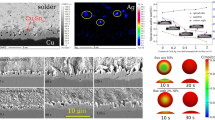Abstract
In order to investigate the effect of \(\text {TiO}_{2}\) nanoparticles on growth behavior of interfacial \(\text {Cu}_6\text {Sn}_5\) intermetallics compounds (IMCs) in Pb-free Sn/Cu system, the solder joints are fabricated by using flux doped with different content (0.0–2.0 wt% of flux) and particle diameter (5 nm and 50 nm) of \(\text {TiO}_{2}\). In context of isothermal reflow soldering at 250 °C and subsequent air cooling, the increase in reflow duration from 10 to 120 s was characterized with an increment in IMC layer thickness and grain size, due to the enhancement of Cu flux contribution for Ostwald ripening during constant temperature reflow and precipitation kinetics during cooling. The increased proportion of \(\text {TiO}_{2}\) nanoparticles in flux was found to reduce the growth of IMC layer and grain size. The suppression effect on IMC was more pronounced for 5 nm particles as compared to the 50 nm \(\text {TiO}_{2}\). The \(\text {TiO}_{2}\) nanoparticles, adsorbed on IMC plane can retard the growth of the latter. Presence of sufficient amount of a given sized \(\text {TiO}_{2}\) nanoparticles among IMCs, by increasing the effective stress at the localized interfaces, and causing the breaking of brittle \(\text {Cu}_6\text {Sn}_5\) during growth stage; can help in the inhibition of IMC whisker formation. Particle diameter and mass proportion of \(\text {TiO}_{2}\) nanoparticles are important for soldering materials design.










Similar content being viewed by others
References
A.S.M.A. Haseeb, Y.M. Leong, M.M. Arafat, In-situ alloying of Sn–3.5Ag solder during reflow through Zn nanoparticle addition and its effects on interfacial intermetallic layers. Intermetallics 54, 86–94 (2014)
M.A.A. Mohd Salleh, S.D. McDonald, C.M. Gourlay, H. Yasuda, K. Nogita, K. Nogita, Suppression of Cu\(_{6}\)Sn\(_{5}\) in TiO\(_{2}\) reinforced solder joints after multiple reflow cycles. Mater. Des. 108, 418–428 (2016)
F. Xing, J. Yao, J. Liang, X. Qiu, Influence of intermetallic growth on the mechanical properties of Zn–Sn–Cu–Bi/Cu solder joints. J. Alloys Compd. 649, 1053–1059 (2015)
F. Xing, Q. Shang, L. Yuzhen, J. Liang, X. Qiu, Intermetallic compounds growth suppression in ZSCB solder with RE addition on Cu substrate. J. Alloys Compd. 666, 122–130 (2016)
Y. Huang, Z. Xiu, W. Gaohui, Y. Tian, P. He, G. Xiaolong, W. Long, Improving shear strength of Sn–3.0Ag–0.5Cu/Cu joints and suppressing intermetallic compounds layer growth by adding graphene nanosheets. Mater. Lett. 169, 262–264 (2016)
Y. Tang, S. Luo, G. Li, Z. Yang, C. Hou, Ripening growth kinetics of Cu\(_{6}\)Sn\(_{5}\) grains in Sn–3.0Ag–0.5Cu–xTiO\(_{2}\)/Cu solder joints during the reflow process. J. Electron. Packag. 140(March), 1–11 (2017)
Y. Tang, G.Y. Li, Y.C. Pan, Effects of TiO\(_{2}\) nanoparticles addition on microstructure, microhardness and tensile properties of Sn–3.0Ag–0.5Cu–xTiO\(_{2}\) composite solder. Mater. Des. 55, 574–582 (2014)
Y. Tang, G.Y. Li, D.Q. Chen, Y.C. Pan, Influence of TiO\(_{2}\) nanoparticles on IMC growth in Sn–3.0Ag–0.5Cu–xTiO\(_{2}\) solder joints during isothermal aging process. J. Mater. Sci. Mater. Electron. 25(2), 981–991 (2014)
Y. Tang, Y.C. Pan, G.Y. Li, Influence of TiO\(_{2}\) nanoparticles on thermal property, wettability and interfacial reaction in Sn–3.0Ag–0.5Cu–xTiO\(_{2}\) composite solder. J. Mater. Sci. Mater. Electron. 24(5), 1587–1594 (2013)
M.A.A. Mohd Salleh, S.D. McDonald, Y. Terada, H. Yasuda, K. Nogita, K. Nogita, Development of a microwave sintered TiO2 reinforced Sn–0.7wt%Cu–0.05wt%Ni alloy. Mater. Des. 82, 136–147 (2015)
G.K. Sujan, A.S.M.A. Haseeb, H. Nishikawa, M.A. Amalina, Interfacial reaction, ball shear strength and fracture surface analysis of lead-free solder joints prepared using cobalt nanoparticle doped flux. J. Alloys Compd. 695(3), 981–990 (2017)
F. Meng, S.A. Morin, A. Forticaux, S. Jin, Screw dislocation driven growth of nanomaterials. Acc. Chem. Res. 46(7), 1616–1626 (2013)
A. Kunwar, B. Guo, S. Shang, P. Råback, Y. Wang, J. Chen, H. Ma, X. Song, N. Zhao, Roles of interfacial heat transfer and relative solder height on segregated growth behavior of intermetallic compounds in Sn/Cu joints during furnace cooling. Intermetallics 93, 186–196 (2018)
D.Q. Yu, L. Wang, C.M.L. Wu, C.M.T. Law, The formation of nano-Ag\(_{3}\)Sn particles on the intermetallic compounds during wetting reaction. J. Alloys Compd. 389(1–2), 153–158 (2005)
C.M.L. Wu, D.Q. Yu, C.M.T. Law, L. Wang, Properties of lead-free solder alloys with rare earth element additions. Mater. Sci. Eng. R Rep. 44(1), 1–44 (2004)
R. Hengzhong Zhang, L. Penn, R.J. Hamers, J.F. Banfield, Enhanced adsorption of molecules on surfaces of nanocrystalline particles. J. Phys. Chem. B 103(22), 4656–4662 (1999)
Q. Jiang, D.S. Zhao, M. Zhao, Size-dependent interface energy and related interface stress. Acta Mater. 49(16), 3143–3147 (2001)
E. Buchovecky, N. Jadhav, A.F. Bower, E. Chason, Finite element modeling of stress evolution in Sn films due to growth of the Cu\(_{6}\)Sn\(_{5}\) intermetallic compound. J. Electron. Mater. 38(12), 2676–2684 (2009)
J. Hektor, M. Ristinmaa, H. Hallberg, S.A. Hall, S. Iyengar, Coupled diffusion-deformation multiphase field model for elastoplastic materials applied to the growth of Cu\(_{6}\)Sn\(_{5}\). Acta Mater. 108, 98–109 (2016)
L. Liu, Z. Chen, C. Liu, W. Yiping, B. An, Micro-mechanical and fracture characteristics of Cu\(_{6}\)Sn\(_{5}\) and Cu\(_{3}\)Sn intermetallic compounds under micro-cantilever bending. Intermetallics 76, 10–17 (2016)
S.F. Choudhury, L. Ladani, Miniaturization of micro-solder bumps and effect of IMC on stress distribution. J. Electron. Mater. 45(7), 3683–3694 (2016)
A. Kunwar, H. Ma, J. Sun, S. Li, J. Liu, Modeling the diffusion-driven growth of a pre-existing gas bubble in molten tin. Met. Mater. Int. 21(5), 962–970 (2015)
S.F. Choudhury, L. Ladani, Single crystal plasticity finite element analysis of Cu\(_{6}\)Sn\(_{5}\) intermetallic. Metall. Mater. Trans. A 46(3), 1108–1118 (2015)
Acknowledgements
This work was supported by the National Natural Science Foundation of China (Grant Nos: 51871040 and 51571049) and “Research Fund for International Young Scientists” of National Natural Science Foundation of China (Grant No: 51750110504).
Author information
Authors and Affiliations
Corresponding authors
Rights and permissions
About this article
Cite this article
Shang, S., Kunwar, A., Yao, J. et al. Effect of the \(\text {TiO}_2\) Nanoparticles on the Growth Behavior of Intermetallics in Sn/Cu Solder Joints. Met. Mater. Int. 25, 499–507 (2019). https://doi.org/10.1007/s12540-018-0189-1
Received:
Accepted:
Published:
Issue Date:
DOI: https://doi.org/10.1007/s12540-018-0189-1




